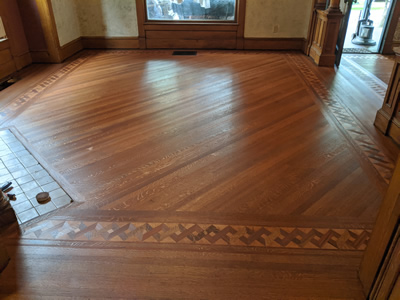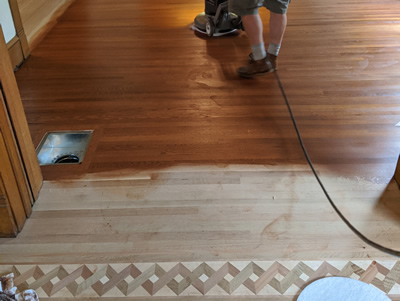
by Everett 5/25/2020

The day has finally come, it's time to apply the Rubio Monocoat. This stuff is similar to staining but a little more difficult. You have to apply it in smaller sections, wait for it to react with the wood for 3-5 minutes, buff it with a red pad to knock the grain down from the water popping, then buff over it with the white pad, and finally a couple times with terry cloth towels-- all within 15 minutes. So it’s kind of hair raising at first. I’m sure that some day I’ll be as comfortable with this procedure as I am with anything else we do, but for now it's a little nerve wracking until we do the first couple stints and get into something of a groove.

The two most popular ways to apply RMC oil are buffing or trowelling. My preference is generally to trowel it on, the two main reasons being that it makes the material go further since you’re not saturating a pad with so much oil (which just gets thrown away), and secondly I read once that by buffing it on you’re also introducing heat. This can reduce the open time of the product and make it set up faster, making it more difficult to buff off. The problem is that I’ve never troweled RMC onto a water popped floor. When a floor is water popped, you have to be very careful not to crush the grain back down. Tipping the buffer on the corner of the wheel, stepping on the floor with the side of your shoe, or stepping on a cord, things like that can and will crush the grain down and show up at the worst possible time. Now you’re getting out the sand paper and doing a spot fix right then and there during the application. So my worry was that I would crush the grain down with the corners of the trowel, luckily this turned out to not be a concern.

I’m glad I decided to go forward with troweling too- we hit this one close on the material we had, way too close. We mixed up 2L of the custom color blend, which ends up being 2.6L after adding the activator. This should have been more than enough but apparently it wasn't. I don’t know if it was the gaps in the old floor (they shouldn’t have been much of a factor since we trowel filled it) or if it was just the old wood itself absorbing more oil, but towards the end we had just a few square feet left and we were out. I was wiping the inside of my cup out with gloved hands trying to get every last drop. In the end our red pad had enough oil in it to cover that last little bit and we had dodged a huge bullet. Had we run out we would have had to order more of the main color of the blend and that wouldn’t have come in until mid week the next week. Needless to say we were ecstatic to be able to finish up that day.

Still to this day I worry a little about looming stain days. Even though we’ve been at this for almost 20 years and produced countless near perfect jobs, there’s always that nagging possibility in the back of my head that as soon as we start applying color, there’s going to be a horrid scratch pattern or some bad scratch from a previous grit that got missed. What little thought I had of this happening here was unwarranted. Thanks to good ol’ Norton MeshPower, while sanding I could see the scratches from the last pass disappearing as I went across the floor with only one(!) set for just over 1000 square feet. It’s weird, it kind of polishes the wood but doesn’t burnish it somehow. It’s so nice to have products available to us that allow us to be confident in our work when that staining day comes.
After we install the trim that’ll be a wrap. It was a long road, but what a fantastic floor!


